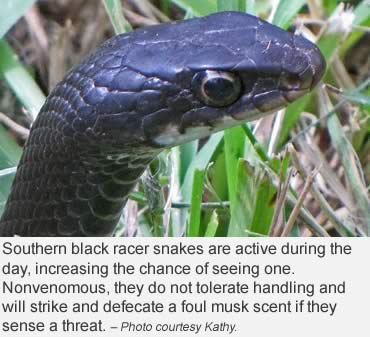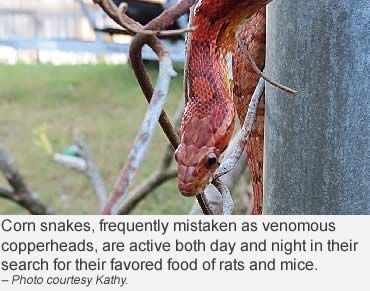Photo: This heavy-bodied, semiaquatic nonvenomous snake is often confused with the venomous western cottonmouth and needlessly killed. Admire it from a distance and you’ll both be happier.
It’s summer and snakes are on the move. If you shudder when you see one slither, you’re not alone.
But there is a simple way to slow that rapid heartbeat and calm the adrenaline rush.
If you see one, respect it and give it plenty of space to avoid problems. Don’t harass it, don’t approach it. Just leave it alone.
That’s sound advice, says Kevin Wheeler, a biologist with the Utah Division of Wildlife Resources, and his recommendation is echoed by biologists and herpetologists everywhere.
Warm and hot weather means it’s not unusual to see nonvenomous snakes in summer. Although venomous snakes pose a bigger threat, nonvenomous snakes can also pose a health risk. A nonvenomous snake bite, if left untreated, could cause a serious infection.
Unfortunately, one of the greatest health risks from a nonvenomous snake is the way humans react. People often end up hurting themselves by trying to get away from a snake. Instead, move slowly, don’t panic. You move on, and the snake will move on.
Dangerous situations with venomous snakes also can be avoided.
For example, Wheeler says most people bitten by rattlesnakes are bitten while harassing, toying with a snake or trying to kill it. Like most animals, rattlesnakes fear humans and will do anything to avoid us.
"That changes if a snake thinks it's threatened and there's no way to escape," he says. "In that case, the snake will often strike to protect itself."
So how can you avoid that unpleasant surprise factor of seeing a snake?
The secret is to become aware of places where snakes are found. Look for them just about anywhere, says Dr. Jim Armstrong, an Alabama Extension Service wildlife specialist.
 Around homes, snakes commonly are found in sheds, barns, flower beds, gardens and wood piles.
Around homes, snakes commonly are found in sheds, barns, flower beds, gardens and wood piles.
“Snakes are most likely to be found in areas that provide cover or shelter for them and their prey,” Armstrong said. “Removing these types of areas from around your house will help reduce, but not eliminate, the possibility of snakes around the home.”
As for rattlesnakes, if you see one, give it space and don’t harass it, Wheeler advises. “Don’t approach it. Give it plenty of space and leave it alone.”
Armstrong said any snake can be aggressive.
“Overall, most snakes, regardless of species, are not aggressive. However, any snake, venomous or not, may be aggressive if cornered or picked up,” he said. “Some species tend to bite more readily than others, but there is great variation even within a species.”
To avoid conflict, you can help snakes avoid your property. Wheeler also offers tips on how to do that.
• Reduce the number of places that provide snakes with shelter. Brush, wood, rock and junk piles are all items you should get rid of.
• Control rodent populations. Bird feeders and water are two of the main items that draw rodents to yards.
• Avoid scaring away harmless snake species such as gopher snakes. Having other snake species on or near your yard may deter rattlesnakes from wandering through.
• Wheeler says he's heard of people using snake repellents, but he isn't aware of any scientific testing that shows these products are effective.
And, if you enjoy hiking trails in parks and recreation areas, watch the trail ahead of you. As a general rule, Armstrong said, if you are in an area where snakes might be present, closed-toe shoes and long pants are a must.
Check carefully before stepping over rocks, reaching onto ledges or sitting down on a rock or log.
 If you see a rattlesnake, Wheeler has more advice.
If you see a rattlesnake, Wheeler has more advice.
• Remain calm. Do not panic. Rattlesnakes will not chase you.
• Stay at least five feet from the snake. Give it plenty of space.
• Do not try to kill the snake. Doing so in Utah, for example, is illegal and greatly increases the chance the snake will bite you.
• Alert others to the snake's location. Advise them to use caution and to respect the snake. Keep children and pets away.
• Keep your dog on a leash. Allowing your dog to roam increases the chance the dog will find a snake and get bitten.
From the Southeast to the Southwest, snake advice is abundant.
Find more information about snakes in the Alabama Extension’s publication, “Identification and Control of Snakes in Alabama.” This includes some common myths about snakes, both venomous and nonvenomous. See the full publication here.
Find rattlesnake safety tips at the Wild Aware Utah website. Southwest Partners also provides rattlesnake safety information. A copy of the organization's free "Living with Venomous Reptiles" brochure is available online.
Resources: Alabama Cooperative Extension Service, Utah Division of Wildlife Resources.